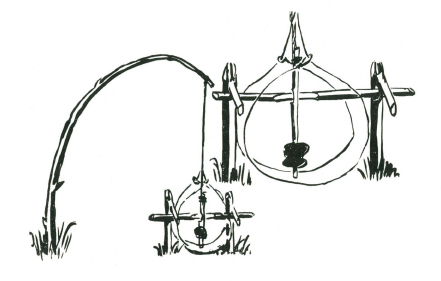Knowing the animal which you are hoping to trap will enable you to decide whether to set the release ‘fine’ or whether to set it ‘tough,’ so that the animal will have to tug and worry the bait, and thereby become bold and unsuspicious.
Included in these traps are a few which could be exceedingly dangerous to man. These are given because they are very little known, and could possibly be of great value to explorers or others. Several of these man-killers were devised during the War in the Pacific by men who were adrift in the jungle and used these ‘automatic sentries’ to make their camps safe from attack by hostile natives or enemy forces.
Some of the traps are illegal in certain countries, and the trapper should acquaint himself with the local game and trapping laws.
The type of trap you must make depends largely upon the animal for which it is being set, and the local conditions. Only experience can guide you in deciding which trap or snare will serve you best.
SIMPLE SNARE

Snare set over rabbit burrow.
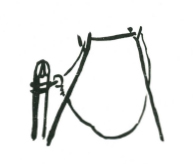
Snare set in path, held in position with twigs.
This is merely a running noose set either in the entrance to a burrow or other hiding place of the animal, or else set across one of its paths. The noose should be of some strong material; fine brass wire (picture wire) is probably about the best. The brass is stiff enough to bend easily into shape, the noose will stand by itself, and being very thin it will probably not be seen by the animal, and yet it is strong enough to hold the snared creature captive. One end must be very securely fastened to a peg or other reliable anchor.
If fine wire is not available for noose snares, cord can be used, or if this not available it can be spun, plaited, or twisted from local fibrous material.
Generally when cord is being used it will be necessary to hold the noose spread open. Very thin twigs can be used for this purpose. They should be set lightly in the ground, and have just enough strength to hold the noose open. Remember that the snared animal has sharp teeth and therefore the ability to chew its way out of the snare if given time. Wire obviously is difficult for the animal to bite, but with cord there is no difficulty, and an animal can release itself in a few minutes if it does not panic and struggle forward into the noose, as so often happens. When you set the noose snare it must be visited regularly at short intervals.
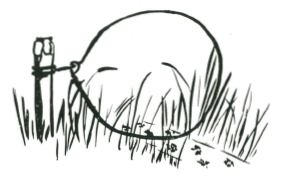
Snare set in ajimal path.
GROUND SNARE
TOGGLE AND BAIT STICK RELEASE
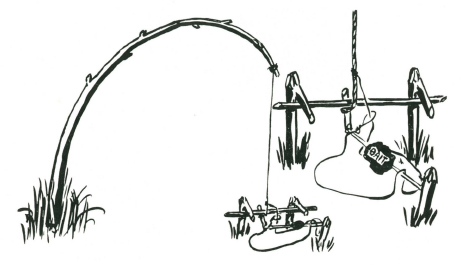
Select a site where there is a springy sapling. Lop the sapling of its branches and top. Bend the sapling over, and make a mark on the ground under the head of the bent sapling. This is the place where you will set the sticks for the snare. Cut two hooked stakes. These should be sharpened at the point, and bevelled at the head so they will drive easily into the ground. They must be straight and strong, and preferably cut from dead wood. The hooks should be about two to three inches above ground level. Between the two hooks, and about twelve inches in front of them an anchor peg is driven into the ground. Three straight sticks for the release are selected. One must be long enough to go between the two forks and lie under them. The other is only about three inches long and is the toggle stick, and the third, which is about twelve inches long, is the bait stick. A stout cord is tied to the head of the lopped sapling, and the sapling itself is bent so that the head is over the two hooked stakes. Where the cord from the head of the sapling touches the cross stick the toggle stick, is tied securely, and above it another cord is tied and formed into running noose.
The toggle stick is passed in front of the stick between the two hooked sticks, and under, so that the cord lies hard against the front side cross stick.
The lower end of the toggle stick presses against the bait stick, which in turn presses against the anchor peg. The noose is laid over the bait stick.
When the animal touches the bait stick, it frees the toggle stick, and the upward spring of the sapling, acting swiftly, draws the noose round the captive bird or animal.
This snare should not be left set for more than twelve hours at a time. If the sapling is kept bent for too long it will lose its springiness, and render the snare ineffective.
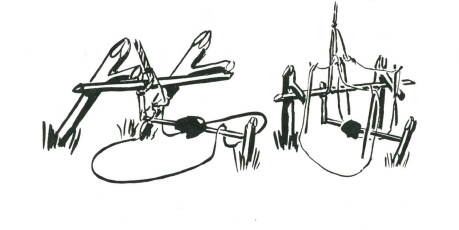
An alternative release may be effected by using two forks driven in at such an angle that the cross stick is pulled against the lower side of the fork.
The setting of the noose may be varied for certain types of ground feeding creatures so that the noose, instead of lying flat on the ground, over the bait stick, is held vertically so that the animal or bird must put its head through the noose to reach the bait.
GROUND SNARE
TOGGLE AND BAIT STICK RELEASE
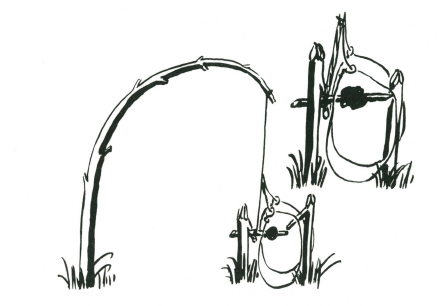
In this snare a springy sapling is lopped of its top and branches. Two strong hooked stakes are cut, and one with a shorter hook is driven into the ground directly beneath where the head of the sapling comes when it is bent over. At right angles to the hook of this stake, the other hooked stake is driven into the ground. It should be about one foot distant. The cord for the snare is tied to the head of the sapling, and the noose made in another cord tied just above the free end. The free end is tied to the bait stick, which held beneath the fork of one stake, is pulled upwards against the prong of the hook of the other stake. Setting can be varied in sensitivity by narrowing down the edge of the hook against which the bait stick is pulled. Noose, or nooses should be vertical and spread a few inches away from the bait, so that the animal must put its head or forequarters inside the noose to reach the bait.
This snare should be released after about twelve hours of setting to restore the springiness to the sapling.
GROUND SNARE
REVERSED TOGGLE BAIT STICK RELEASE
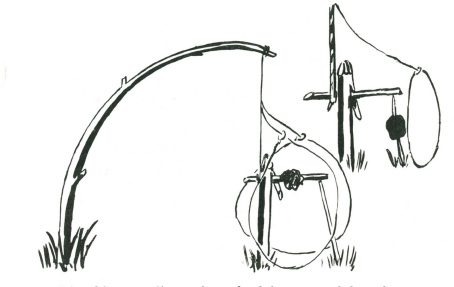
A whippy sapling, trimmed of its top and branches to reduce the weight, is bent over, and directly beneath its head a very stout hooked stake is driven into the ground.
A strong cord is tied to the head of the sapling, and the other end of the cord is tied an inch or so from one end of a toggle stick some eight to ten inches long. This long end of the toggle stick is passed under the fork of the hooked stick (see sketch). The bait may either be placed on this toggle stick, or alternatively on the stick which it presses to the ground.
A noose is tied to the cord above the tie of the toggle stick, and brought forward, and held in position by thin twigs (not shown) so that it is a few inches in front of the bait stick. If the toggle stick is used to carry the bait it is advisable to put out two nooses, one on either side of the bait.
Care must be taken to see that the long end of the toggle stick is short enough to pass freely under the hooked stick. If the toggle stick is too long it will simply smack down on the ground and jam the release. It must be short enough to swing completely free under the hook.
GROUND SNARE
STEPPED BAIT STICK RELEASE
